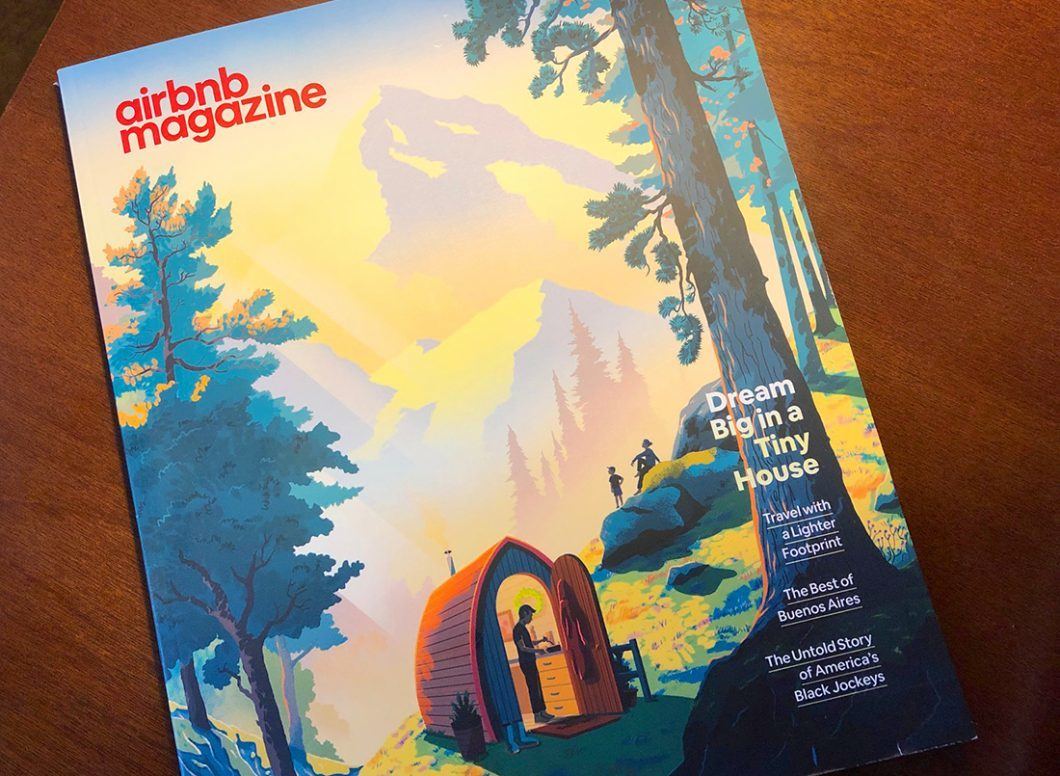
Catarina Alves de Sousa
Social Media Manager & Content Writer
Content marketing is a marketing strategy that concerns the creation, publication, and distribution of relevant, useful, and consistent content to attract and retain a clearly defined target audience, with the ultimate goal of driving action from readers.
In the case of this article, our goal is that you read it to the end and put into practice what you learn here to boost your brand or business.

Catarina Alves de Sousa
Social Media Manager & Content Writer
Content marketing is a marketing strategy that concerns the creation, publication, and distribution of relevant, useful, and consistent content to attract and retain a clearly defined target audience, with the ultimate goal of driving action from readers.
In the case of this article, our goal is that you read it to the end and put into practice what you learn here to boost your brand or business.
No matter what you say about the decrease in cybernauts’ attention span and interest in long-form content, the truth is that content marketing is still one of the most powerful marketing tools.
Among the main functions of content marketing, the following stand out:
- Attract and retain audience attention: by sharing valuable information with the target audience;
- Build trust and authority: by providing high-quality content;
- Improve SEO: quality content can help improve a company’s search engine ranking, making it more visible to potential customers;
- Generate leads and sales: content marketing can be used to capture contact information from potential customers (leads) or to encourage direct purchases;
- Nurture customer relationships: content marketing does not end with the sale. It can be used to continue to provide value to customers, keeping them engaged and encouraging brand loyalty and repeat sales.
- Educate the public: Content marketing can also be used to educate the public about a company’s products or services, helping them understand why they are the best choice.
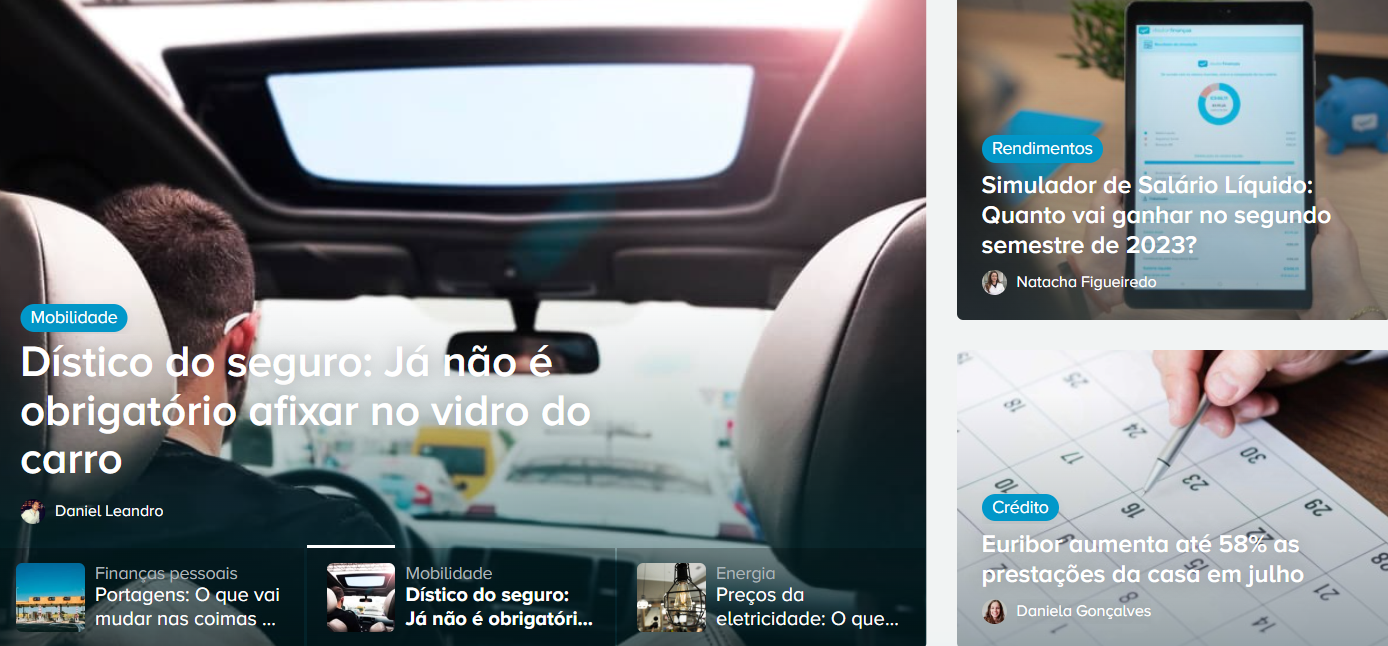 Source: Doutor Finanças
Source: Doutor Finanças
The Portuguese fintech Doutor Finanças offers several contents that aim only to inform readers that is, they add value without the intention of buying or capturing leads. In other articles on topics more in line with the service they offer, they post contact forms. Different content for different intentions and stages of the funnel (we will go there later).
Having addressed the importance that Content Marketing has for companies, we must now explore its funnel.
What is a Content Marketing Funnel?
A Content Marketing Funnel is a visual representation of the customer journey, from the first point of contact with your brand to the final conversion. This journey is usually divided into three stages: top of the funnel (ToFu), middle of the funnel (MoFu), and bottom of the funnel (BoFu). Each stage requires different types of content to move prospects through the funnel toward the desired action.
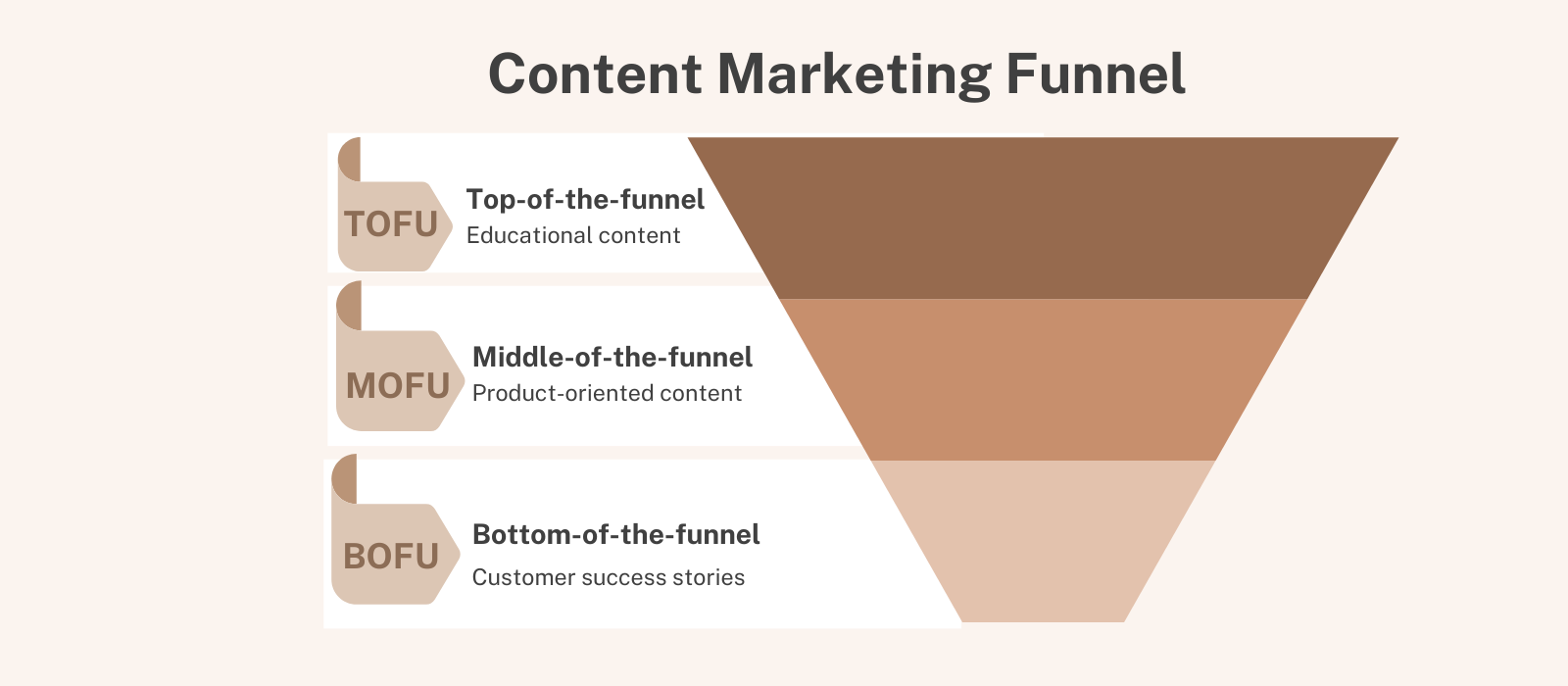 Source: Search Engine Journal
Source: Search Engine Journal
How to start mapping your Content Marketing Funnel?
Mapping your Content Marketing Funnel can seem like a daunting task, but it doesn’t have to be. Here are some steps to get you started simply:
- Identify your target audience: first of all, you need to understand who your target audience is. What are their needs, wants, and challenges? What kind of content do they find valuable?
- Define the stages of your funnel: as mentioned earlier, a content marketing funnel is usually divided into ToFu, MoFu, and BoFu. However, your funnel may have more or fewer stages depending on your business and your target audience. Use this guide as inspiration, but feel free to customize your funnel!
- Map the content for each stage: once the stages of the funnel are defined, it’s time to map the content for each of them. What type of content will attract your target audience into the funnel? What type of content will take them to the next stage?
What to do after mapping all the stages of the Funnel?
Once you’ve mapped out all the stages of your Content Marketing Funnel, the work isn’t over yet. Here are the actions you need to take in the next step:
- Produce and distribute the content: now that you have a plan, it is time to create and distribute the content. Remember that quality is more important than quantity.
- Monitor and adjust: use analytics tools to monitor the performance of your content. Are you attracting and moving the audience through the funnel as expected? If not, you may need to adjust your content or your strategy.
What is the best content for each stage of the funnel?
To answer this question, we would have to analyze your company (and we can do that if you wish!). The type of content that works best will vary depending on your target audience and your industry, but here are some general suggestions:
Top of the Funnel – ToFu: generate interest and capture attention
The top of the funnel is the starting point of the buyer’s journey and is the most populated stage. Here, people aren’t ready to buy yet and have probably never heard of your company.
The goal at this stage is to therefore attract the audience. According to a SEMRUSH study, the most effective types of content for this stage tend to be more educational and add value, which helps drive users and readers to your website.
ToFu is usually measured by the following metrics:
- Organic traffic, referral traffic, and total traffic;
- Engagement on social media (shares, comments, likes);
- Influencer and media mentions;
- Website engagement metrics (bounce rate, time spent on page);
- Newsletter subscriptions.
Based on the same study, these are the top five types of content that work best at the top of the funnel:
- How-to guides
- Landing pages
- Infographics
- Checklists
- E-books
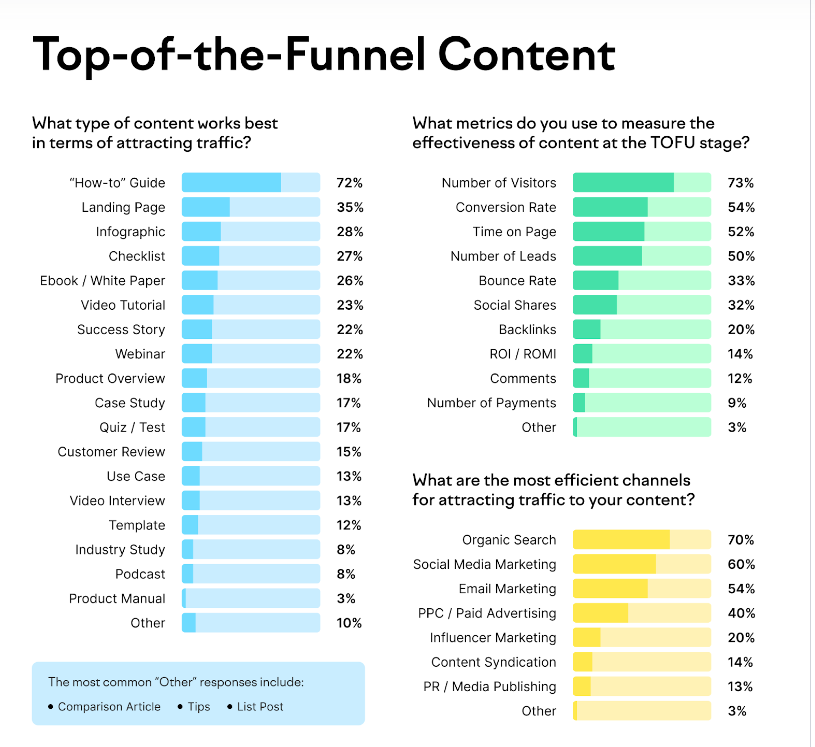 Source: SEMRUSH
Source: SEMRUSH
Middle of the funnel – MoFu: guide and educate
In this step, the goal is to nurture the leads and move them to the next state. The content should be more in-depth and specific. Here, the goal is to convert leads into customers. Content should be highly personalized and focused on demonstrating the value of your product or service.
MoFu content is usually measured by conversion rates and the number of leads. Typically, mid-funnel content still generates more traffic from organic searches.
At this stage, the top five commonly used content types include:
- How-to guides
- Product overviews
- Case studies
- Landing pages
- Webinars
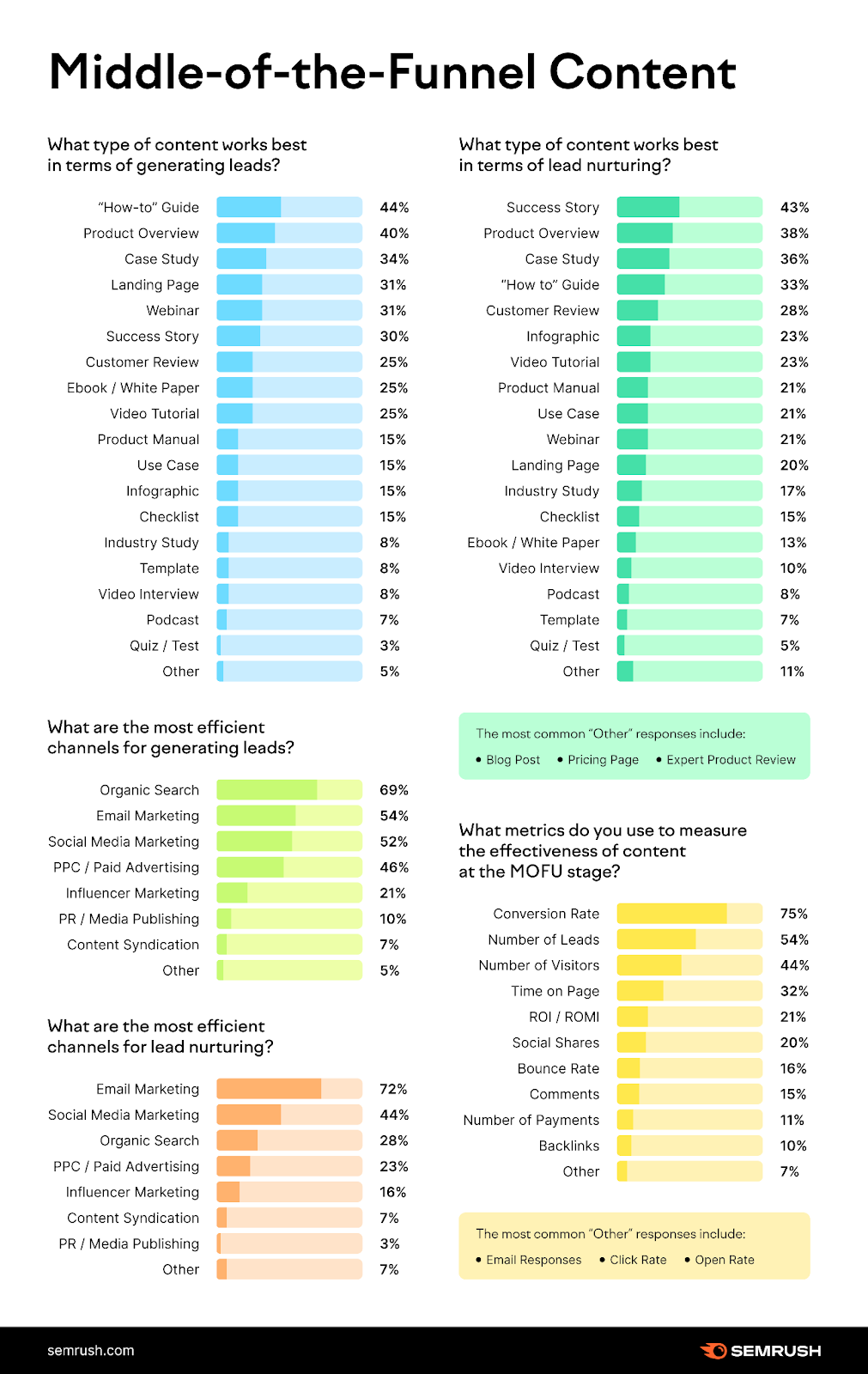 Source: SEMRUSH
Source: SEMRUSH
Bottom of the Funnel – BoFu
The bottom-of-the-funnel stage is the finish line, where content can help position your brand as superior to competitors, build trust and accelerate purchases.
The content you create at this stage should answer very specific questions about your product or service (for example, how it works or what skills are needed to handle it).
The three main types of content for the BOFU stage are:
- Product overview
- Customer reviews
- Success stories
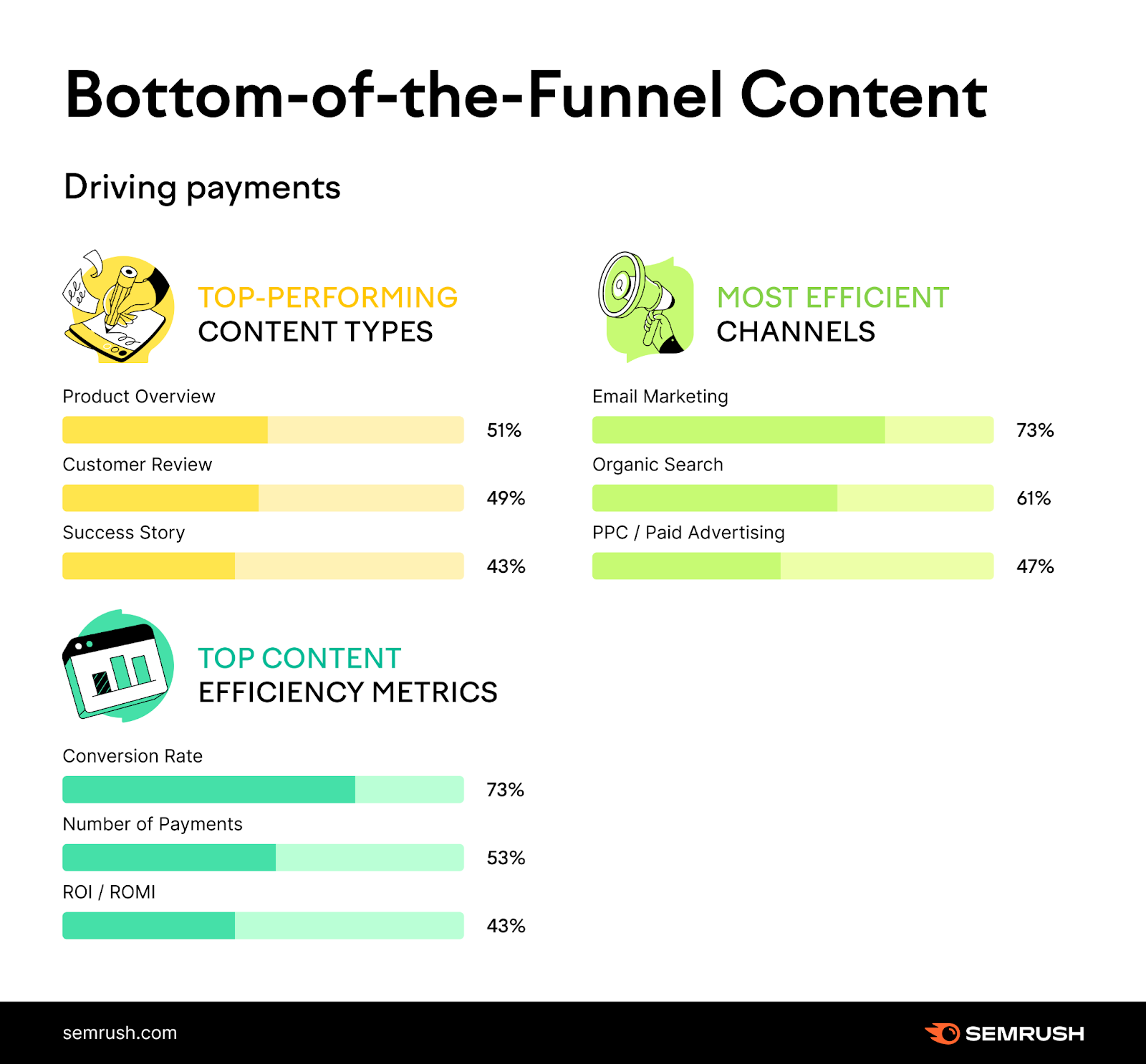 Source: SEMRUSH
Source: SEMRUSH
Tips and Good Practices
To conclude, here are some tips and best practices for your Content Marketing Funnel:
- Know your audience: the key to effective content marketing is understanding your audience. The more you know about them, the more effective your content will be.
- Be consistent: consistency is key when it comes to content marketing. This not only means being consistent in publishing content but also in maintaining a consistent brand voice and style.
- Use multiple content formats: Don’t limit yourself to one type of content. Experiment with different formats to see what works best for your audience.
- Optimize for SEO: SEO is crucial for attracting traffic to your content. Make sure your content is optimized for search engines.
- Measure and adjust: Finally, remember that content marketing is an ongoing process. Frequently measure the performance of your content and adjust it to your strategy as needed.
Source: Airbnb Magazine, um exemplo de diversificação na produção de conteúdos
A Content Marketing Funnel is a powerful tool to attract, engage and convert your audience. With careful planning and strategic execution, you can use content marketing to drive your business growth.
If you need help developing a 100% customized content strategy tailored to your audience and business characteristics, talk to us.
